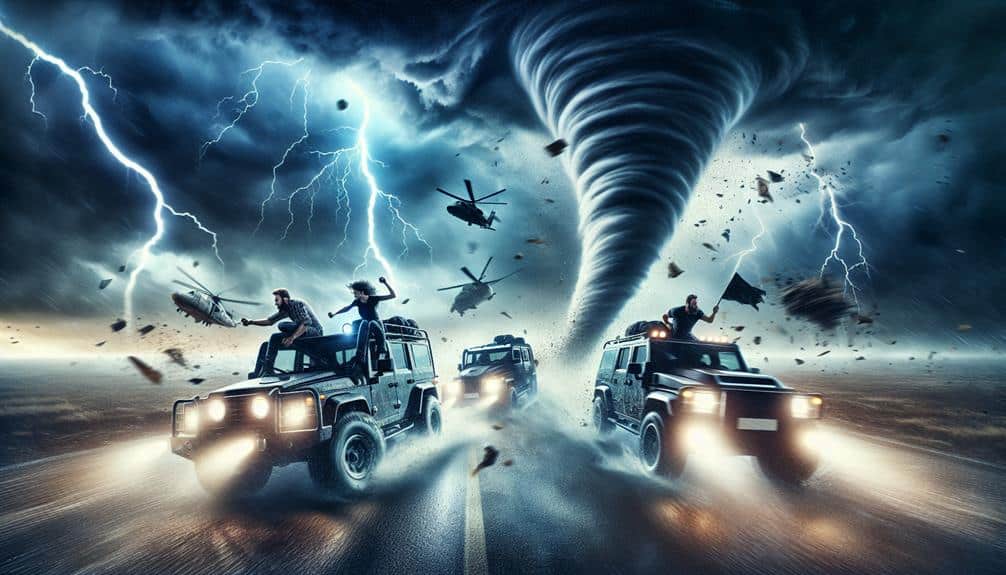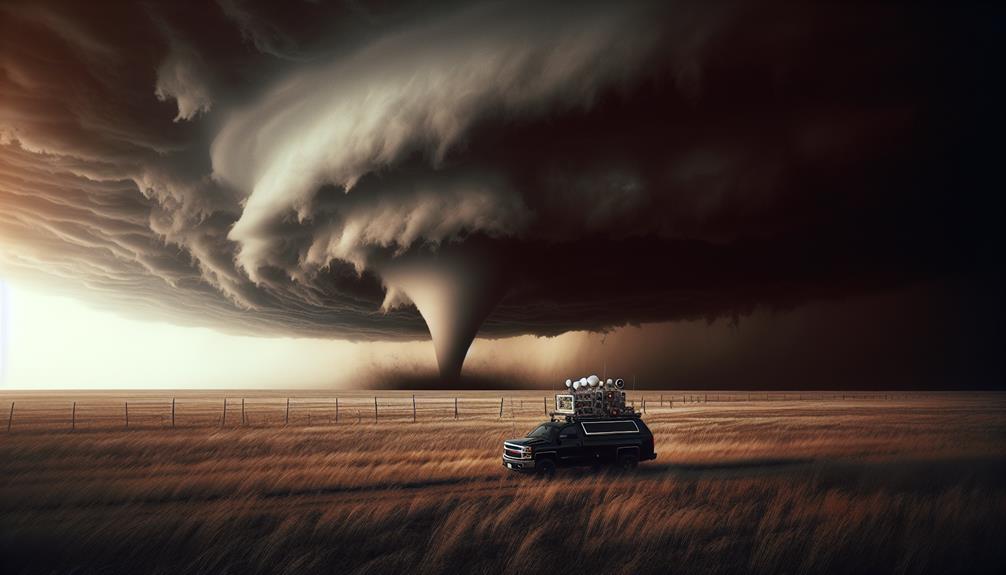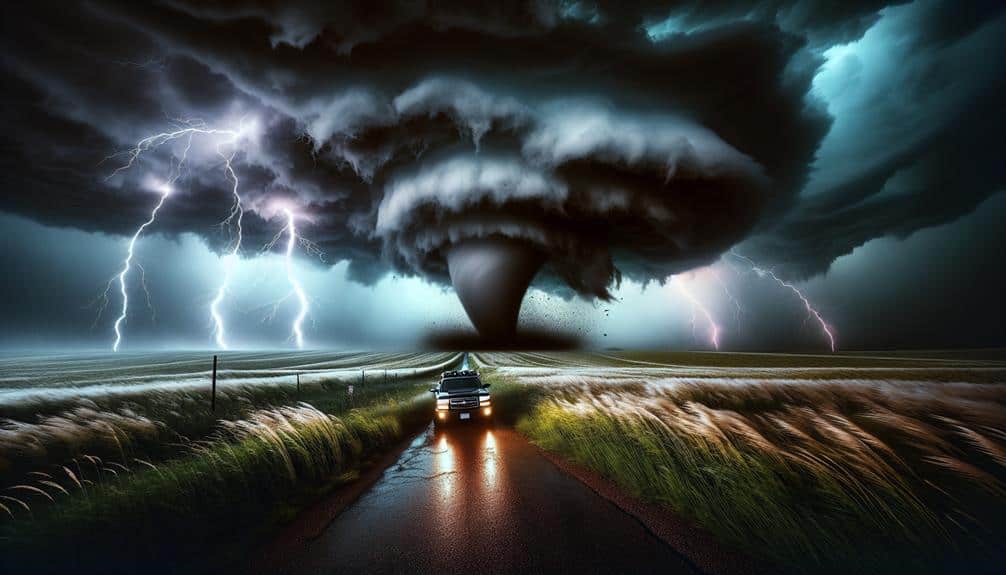To survive storm chasing, we carefully plan our route using high-definition maps and real-time radar data, and equip our vehicles with weather-resistant gear and accurate meteorological instruments. Mastering weather forecasting is essential, analyzing climate patterns and using predictive models for storm behavior assessments. We stay informed with continuous updates from the National Weather Service and utilize strong communication protocols to guarantee team coordination. Practicing defensive driving and knowing when to retreat based on real-time conditions are crucial. Each step captures the accuracy and diligence needed to navigate storm chasing successfully; there's more to uncover for best outcomes.
Key Points
- Monitor real-time weather data constantly for the latest developments and safety alerts.
- Equip your vehicle with weather-resistant gear and maintain it regularly for reliability.
- Plan and pre-identify multiple routes to adapt quickly to changing storm conditions.
- Establish robust communication protocols and use reliable devices for constant contact.
Plan Your Route
Before starting on any storm chasing expedition, we must meticulously map our route using reliable meteorological data and advanced mapping software. Accurate data from the National Weather Service and real-time radar images guide us in predicting storm paths and intensities. By overlaying this information on high-resolution maps, we can create a primary route that maximizes our chances of intercepting severe weather while maintaining safety.
Route flexibility is vital. Dynamic weather conditions necessitate alternate routes to adapt swiftly to unforeseen changes in storm behavior. We should pre-identify multiple viable paths to avoid getting trapped by shifting weather systems. In our planning, we must also consider potential road closures and detour options. Real-time traffic data and local reports are invaluable for identifying which roads are passable and which ones are impassable due to flooding, debris, or other hazards.
We must continuously update our route plans based on evolving weather data and on-the-ground reports. This guarantees we can execute timely detours, avoiding dead ends and dangerous conditions. Our goal is to navigate safely while maintaining the freedom to pursue the most promising storm targets.
Equip Proper Gear
Outfitting our vehicle with specialized equipment is essential for guaranteeing safety and effectiveness during storm chasing expeditions. We must prioritize gear maintenance to keep our equipment in peak condition, as any malfunction could compromise our mission and safety. Securing that our equipment is weather resistant and durable will allow us to operate under extreme conditions without failure.
We should invest in high-quality anemometers, barometers, and portable weather stations for accurate data collection. Additionally, installing reinforced mounts for cameras and GPS units will help us capture and analyze storm dynamics efficiently. For communication, we should rely on robust two-way radios and satellite phones to stay connected when cellular networks fail.
Emergency supplies are non-negotiable. Stocking our vehicle with first aid kits, fire extinguishers, and emergency blankets can make a life-or-death difference. We must also include multiple power sources, such as portable generators and battery packs, to guarantee our equipment remains operational at all times.
In essence, equipping proper gear isn't just about having the latest technology but ensuring our tools are maintained and weather-ready. By being meticulous in our preparation, we maximize our freedom to explore storm patterns safely and effectively.
Understand Weather Patterns
Understanding weather patterns is important for predicting storm behavior and ensuring our safety during expeditions. We need to master the intricacies of weather forecasting to anticipate the development and trajectory of severe storms. Analyzing climate patterns provides us with detailed insights into long-term atmospheric trends, which are essential for identifying high-risk periods and regions.
By leveraging advanced meteorological models, we can interpret data from satellite imagery, Doppler radar, and ground-based weather stations. These tools allow us to monitor variables such as wind speed, humidity, and temperature gradients, which are crucial in storm formation. Recognizing mesoscale and synoptic-scale processes enhances our ability to predict phenomena like supercells and squall lines.
We must also understand the importance of atmospheric instability, vorticity, and shear. These elements play a vital role in storm intensity and structure. By correlating these factors with real-time data, we improve our situational awareness and decision-making capabilities.
Incorporating climatology into our strategies helps us discern seasonal variations and historical storm patterns. This knowledge equips us to chase storms at best times and locations, maximizing both our safety and the quality of our observations. Through diligent study and application of weather forecasting and climate patterns, we can navigate the complexities of storm chasing with greater confidence.
Stay Informed
To stay informed, we must continuously monitor weather updates using advanced meteorological tools and applications.
It's critical that we rely on reputable sources such as the National Weather Service and real-time radar data for accurate information.
Monitor Weather Updates
We need to continuously monitor real-time meteorological data to stay informed about the latest weather developments. Effective weather tracking is pivotal for our storm chasing endeavors. By leveraging advanced radar systems, satellite imagery, and Doppler radar, we can pinpoint storm locations and movement with high accuracy.
Consistent updates from the National Weather Service (NWS) and other meteorological agencies provide the necessary data to anticipate changes in storm intensity, direction, and potential hazards.
Our emergency preparedness hinges on our ability to interpret this data rapidly and accurately. By utilizing weather apps and specialized storm tracking software, we can set up alerts for severe weather conditions, ensuring we're never caught off guard. The integration of GPS technology with weather tracking tools allows us to visualize our proximity to severe weather systems, facilitating smart decision-making on the move.
In our pursuit of storm chasing, we must remember that information is our most powerful tool. Staying updated with the latest meteorological data enables us to make informed decisions, enhancing both our safety and the success of our expeditions.
Real-time monitoring isn't just a precaution; it's an essential element of our strategy to embrace the unpredictability of nature while maintaining our autonomy and safety.
Use Reliable Sources
Accurate meteorological data is only as reliable as the sources we rely on, making it essential to utilize trusted agencies and platforms for our storm chasing information. To ensure we make informed decisions, we must consistently verify credibility and avoid misinformation. This means seeking reputable sources and staying informed with the most current and precise data available.
Let's consider three essential types of sources:
- National Weather Service (NWS): The NWS offers real-time alerts, detailed forecasts, and radar imagery, making sure we've access to the latest meteorological data.
- Storm Prediction Center (SPC): The SPC specializes in severe weather outlooks and mesoscale discussions, providing vital insights into storm development and progression.
Utilizing these sources empowers us to make informed decisions, enhancing our safety and the efficacy of our storm chasing activities. It's not just about having data; it's about having *trustworthy* data.
Maintain Communication
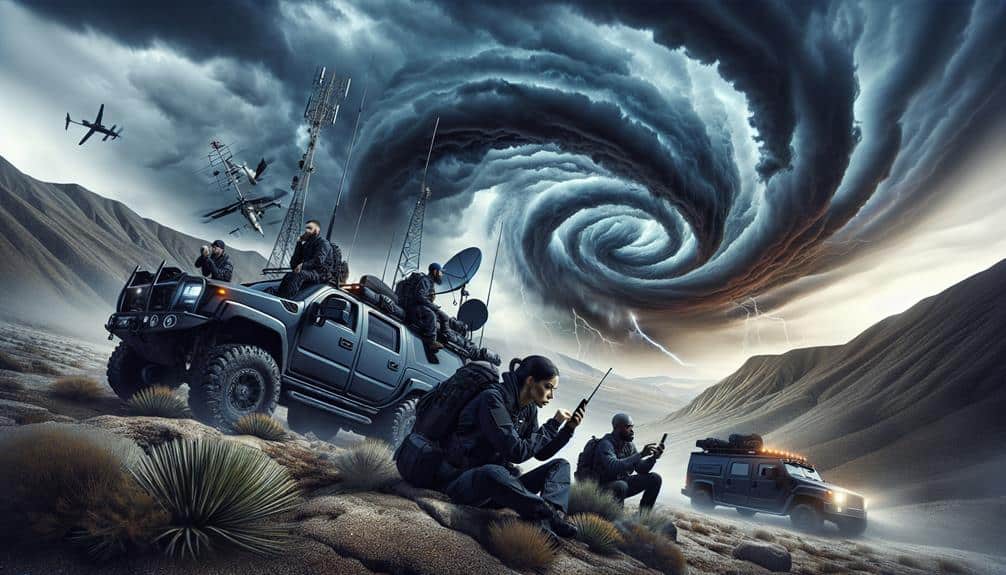
Maintaining clear and constant communication is necessary for coordinating storm chasing activities and ensuring team safety. We must establish robust communication protocols to stay informed and connected.
First, emergency contacts are essential. Each team member should have a list of emergency contacts readily accessible, ensuring immediate support if our primary communication methods fail.
Signal devices such as flares or whistles can be critical in low-visibility conditions. These tools provide a secondary means of alerting team members to our location, especially when electronic communication is compromised.
Weather radios are indispensable for real-time updates. These devices offer precise meteorological data, enabling us to anticipate shifts in storm patterns. NOAA weather radios, in particular, provide continuous updates on severe weather warnings and watches, which is crucial for making informed decisions on the ground.
Satellite phones complement our communication arsenal, ensuring connectivity in areas where cellular networks are unreliable. Unlike traditional mobile phones, satellite phones operate independently of terrestrial cell towers, offering a more reliable communication channel during extreme weather events.
Drive Safely
Adopting defensive driving techniques is crucial for minimizing risks while moving through severe weather conditions. We must remain vigilant about road hazards, which can shift rapidly as storms intensify. Defensive driving involves anticipating potential threats and adjusting our speed and maneuvering strategies accordingly. By staying aware of our surroundings and maintaining a safe following distance, we can better react to sudden changes, such as debris or flooded roads.
Vehicle maintenance is critical. Before heading out, we should conduct a thorough inspection, focusing on:
- The integrity of tires to ensure peak traction.
- The functionality of brakes for precise control.
An emergency kit is essential. It should include essentials like a first aid kit, flashlight, extra batteries, non-perishable food, water, and basic tools. These items can be lifesavers if we find ourselves stranded.
Data from the National Highway Traffic Safety Administration (NHTSA) reveals that appropriate vehicle maintenance and defensive driving can reduce accident rates by up to 30%. Let's prioritize these practices to increase our safety and freedom while engaging in storm chasing.
Freedom comes with responsibility; let's drive smart and stay safe.
Know When to Retreat
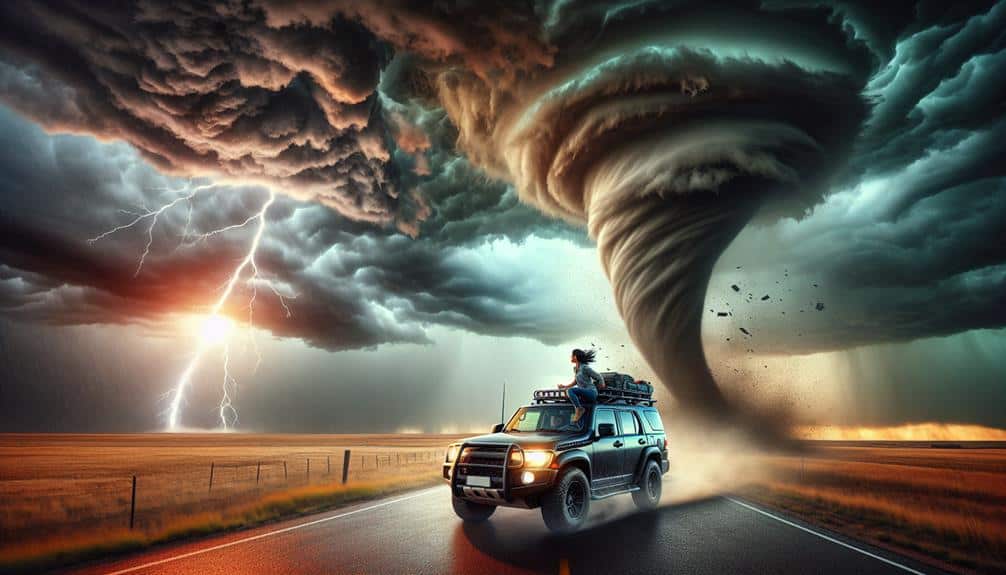
When storm chasing, we must constantly evaluate weather conditions using radar data and predictive models to determine potential threats.
We should monitor safety alerts from reliable sources, such as the National Weather Service, to stay updated on evolving situations.
Recognizing danger signs like sudden wind shifts or rapid drops in pressure is vital for making timely decisions to retreat and guarantee our safety.
Assess Weather Conditions
Why is it important to constantly assess weather conditions and know precisely when to retreat during storm chasing?
The dynamic nature of severe weather systems necessitates continuous weather monitoring and rigorous risk assessment. By closely tracking storm patterns, we can determine the safest course of action and take appropriate safety precautions.
Weather monitoring tools provide us with real-time data vital for making informed decisions. Advanced storm tracking technology, including Doppler radar and satellite imagery, allows us to predict storm trajectories with high accuracy. Knowing when to retreat is crucial; it can mean the difference between exhilarating success and dangerous failure.
Let's consider why real-time assessment is essential:
- Unpredictable Storm Behavior: Tornadoes and supercells can change direction or intensity suddenly, posing unexpected risks.
- Rapidly Deteriorating Conditions: Severe weather can escalate quickly, and staying informed helps us avoid being caught in life-threatening situations.
Monitor Safety Alerts
Monitoring safety alerts in real-time is critical for making timely decisions and guaranteeing our safety during storm chasing. We must stay connected to the National Weather Service (NWS) and other reliable meteorological sources. Utilizing mobile apps and NOAA weather radios ensures we receive instantaneous updates on storm developments, tornado warnings, and flash flood alerts.
It's imperative to remain aware of our proximity to emergency shelters and evacuation routes at all times. Knowing the locations of these safe havens allows us to execute a prompt retreat when conditions worsen. We should program these coordinates into our GPS devices to expedite navigation under duress.
Additionally, we must keep a well-stocked first aid kit and other emergency supplies readily accessible. This includes bandages, antiseptics, flashlights, batteries, and portable chargers. Having these essentials guarantees we can address minor injuries and maintain communication if stranded.
Data from historical storm patterns indicate that early retreats greatly reduce the risk of injury. Therefore, monitoring safety alerts and adhering to them is non-negotiable. By doing so, we maximize our operational freedom while mitigating potential hazards.
Let's prioritize our safety and make informed decisions based on real-time data and predefined safety protocols.
Recognize Danger Signs
Recognizing danger signs is crucial for storm chasers to determine the optimal moment to initiate a retreat. Our ability to gauge when a storm shifts from exhilarating to life-threatening hinges on precise danger awareness and stringent safety measures. When we're out in the field, the margin for error is razor-thin, and quick decision making becomes paramount.
Here are key indicators to watch for:
- Rapidly shifting wind directions: Sudden changes in wind direction can indicate the formation of a tornado or severe downdraft.
- Hailstones larger than golf balls: This signals intense updrafts within the storm, suggesting a high potential for severe weather.
We must prioritize our safety above all else. When these signs manifest, initiating an emergency response isn't just sensible—it's crucial. Each of these indicators should prompt an immediate reassessment of our position relative to the storm's path.
Trusting our data and instincts, we need to be prepared to retreat at a moment's notice. By maintaining heightened danger awareness and adhering to robust safety precautions, we guarantee our storm-chasing adventures remain exciting yet secure.
Frequently Asked Questions
What Are the Legal Considerations for Storm Chasing?
Remember the thrill of crossing state lines on storm chases? We must always respect boundaries, obtain necessary permits, and adhere to safety regulations. Our responsibilities include knowing restrictions to guarantee we don't jeopardize our freedom or others' safety.
How Do I Handle Anxiety While Storm Chasing?
To handle anxiety while storm chasing, we implement coping strategies and prioritize mental health. Utilizing relaxation techniques and establishing strong support systems are essential. Data shows structured approaches notably reduce stress, facilitating greater freedom and decision-making accuracy.
What Are the Ethical Guidelines for Interacting With Local Communities?
When interacting with local communities, we must prioritize respecting boundaries and fostering community engagement. Data shows that informed, respectful communication enhances cooperation. Let's guarantee our actions support local autonomy while gathering accurate, valuable storm data.
Are There Any Recommended Apps for Storm Chasers?
We're always on the lookout for the best tools. For storm tracking and real-time safety alerts, apps like RadarScope and Storm Shield are top choices. They provide precise data, ensuring we stay informed and make swift decisions.
How Can I Document My Storm Chasing Experiences Effectively?
To document our storm chasing experiences effectively, we should use advanced photography techniques like long exposure and HDR. Sharing real-time updates and high-quality images on social media maximizes engagement and guarantees our adventures reach a wider audience.
